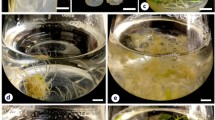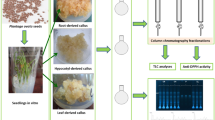Abstract
Plant tissue cultures represent a potential source for producing secondary metabolites. In this work, Buddleja cordata tissue cultures were established in order to produce phenylpropanoids (verbascoside, linarin and hydroxycinnamic acids), as these metabolites are credited with therapeutic properties. Highest callus induction (76.4–84.3%) was obtained in five treatments containing 2,4-Dichlorophenoxyacetic acid (2,4-d: 0.45–9.05 μM) with Kinetin (KIN: 2.32, 4.65 μM), whereas highest root induction (79.6%) corresponded to the α-Naphthaleneacetic acid (9.05 μM) with KIN (2.32 μM) treatment. Verbascoside was the major phenylpropanoid produced in in vitro cultures (root, white and green callus) [66.24–86.26 mg g−1 dry weight (DW)], while linarin and hydroxycinnamic acid production was low (0.95–3.01 mg g−1 DW). Verbascoside and linarin production were improved in cell suspension culture (116 mg g−1 DW and 8.12 mg g−1 DW, respectively).


Similar content being viewed by others
Abbreviations
- ANOVA:
-
Analysis of variance
- DAD:
-
Photodiode array detection
- DW:
-
Dry weight
- GI:
-
Growth index
- HPLC:
-
High performance liquid chromatography
- IAA:
-
Indole-3-acetic acid
- KIN:
-
Kinetin
- μ:
-
Specific growth rate
- MB:
-
Maximum biomass
- NAA:
-
α-Naphthaleneacetic acid
- PGR(s):
-
Plant growth regulator(s)
- qp:
-
Specific production rate
- td:
-
Doubling time
- Y X/S :
-
Yield of biomass from substrate
- 2,4-d :
-
2,4-Dichlorophenoxyacetic acid
References
Aguilar-Rodríguez S, Terrazas T, López-Mata L (2006) Anatomical wood variation of Buddleja cordata (Buddlejaceae) along its natural range in Mexico. Trees (Berl) 20:253–261. doi:10.1007/s00468-005-0007-5
Bourgaud F, Gravot A, Milesi S, Gontier E (2001) Production of plant secondary metabolites: a historical perspective. Plant Sci 161:839–851. doi:10.1016/S0168-9452(01)00490-3
Buchanan BB, Gruissem W, Jones RL (2000) Biochemistry and molecular biology of plants. American Society of Plants Physiologists, Maryland
Dell B, Elsegood C, Ghisalberti E (1989) Production of verbascoside in callus tissue of Eremophila spp. Phytochemistry 28:1871–1872. doi:10.1016/S0031-9422(00)97876-2
Dhakulkar S, Ganapathi TR, Bhargava S, Bapat VA (2005) Induction of hairy roots in Gmelina arborea Roxb. and production of verbascoside in hairy roots. Plant Sci 169:812–818. doi:10.1016/j.plantsci.2005.05.014
Dubois M, Gilles KA, Hamilton JK, Rebers PA, Smith F (1956) Colorimetric method for determination of sugars and related substances. Anal Chem 28:350–356. doi:10.1021/ac60111a017
Ellis BE (1983) Production of hydroxyphenylethanol glycosides in suspencion cultures of Syringa vulgaris. Phytochemistry 22:1941–1943. doi:10.1016/0031-9422(83)80018-1
Fernandez S, Wasowski C, Paladini AC, Marder M (2004) Sedative and sleep-enhancing properties of linarin, a flavonoid-isolated from Valeriana officinalis. Pharmacol Biochem Behav 77:399–404. doi:10.1016/j.pbb.2003.12.003
Houghton PJ, Mensah AY, Iessa N, Hong LY (2003) Terpenoids in Buddleja: relevance to chemosystematics, chemical ecology and biological activity. Phytochemistry 64:385–393. doi:10.1016/S0031-9422(03)00264-4
Inagaki N, Nishimura H, Okada M, Mitsuhashi H (1991) Verbascoside production by plant cell cultures. Plant Cell Rep 9:484–487. doi:10.1007/BF00232101
Kepinski S (2006) Integrating hormone signaling and patterning mechanisms in plant development. Curr Opin Plant Biol 9:28–34. doi:10.1016/j.pbi.2005.11.001
Li L, Tsao R, Liu Z, Liu S, Yang R, Young JC, Zhu H, Deng Z, Xie M, Fu Z (2005) Isolation and purification of acteoside and isoacteoside from Plantago psyllium L. by high-speed counter-current chromatography. J Chromatogr A 1063:161–169. doi:10.1016/j.chroma.2004.11.024
Martínez M (1989) Las plantas medicinales de México. Ediciones Botas, México
Martínez-Vázquez M, Ramírez-Apan TO, Lastra AL, Bye R (1998) A comparative study of the analgesic and anti-inflammatory activities of pectolinarin isolated from Cirsium subcoriaceum and linarin isolated from Buddleia cordata. Planta Med 64:134–137
Murashige T, Skoog F (1962) A revised medium for rapid growth and bioassays with tobacco tissue cultures. Physiol Plant 15:473–497. doi:10.1111/j.1399-3054.1962.tb08052.x
Nezbedova L, Hesse M, Dusek J, Werner C (1999) Chemical potential of Aphelandra sp. cell cultures. Plant Cell Tissue Org 58:133–140. doi:10.1023/A:1006363612428
Oksman-Caldentey KM, Inze D (2004) Plant cell factories in the post-genomic era: new ways to produce designer secondary metabolites. Trends Plant Sci 9:433–440. doi:10.1016/j.tplants.2004.07.006
Orozco-Sánchez F, Rodríguez-Monroy M (2007) Cell suspension culture of Azadirachta indica for production of a bioinsecticide. Rev Mex Ing Quim 6:251–258
Pareilleux A, Vinas R (1983) Influence of the aeration rate on the growth yield in suspension cultures of Carharanthus roseus (L.) G. Don. J Ferment Technol 61:429–433
Pierik R (1990) Cultivo in vitro de las plantas superiores. Mundi-prensa, España
Pletsch M, Piacente S, Pizza C, Charlwood B (1993) The accumulation of phenylpropanoid glycosides in tissue cultures of Tecoma sambucifolium. Phytochemistry 34:161–165. doi:10.1016/S0031-9422(00)90799-4
Quintero R (1993) Ingeniería bioquímica. Alhambra mexicana, México
Sarin R (2005) Useful metabolites from plant tissue cultures. Biotechnology 4:79–93
Shoyama Y, Matsumoto M, Nishioka I (1986) Four caffeoyl glycosides from callus tissue of Rehmannia glutinosa. Phytochemistry 25:1633–1636. doi:10.1016/S0031-9422(00)81224-8
Skrzypek Z, Wysokinska H (1997) Phenolics from cell suspension cultures of Penstemon serrulatus; relation to plant organs. Z Naturforsch 52c:426–432
Skrzypek Z, Wysokinska H (1999) Accumulation of phenylethanoids in suspension cultures of Penstemon serrulatus Menz. Biotechnol Lett 21:691–693. doi:10.1023/A:1005554224150
Wysokinska H, Rozga M (1998) Establishment of transformed root cultures of Paulownia tomentosa for verbascoside production. J Plant Physiol 152:78–83
Yamamoto H, Yoshida K, Kondo Y, Inoue K (1998) Production of cornoside in Abeliophyllum distichum cell suspension cultures. Phytochemistry 48:273–277. doi:10.1016/S0031-9422(97)01134-5
Acknowledgements
The authors thank the Programa de Apoyo de la Investigación Multidisciplinario (Desarrollo de fitomedicamentos a partir de plantas medicinales y sus extractos para el control de la diabetes mellitus) for the partial financing of this project, and the Consejo Nacional de Ciencia y Tecnología (CONACyT) through grant 81157. We also thank Biologist Jorge Santana Carrillo at UAM-I herbarium for taxonomic identification of the collected plant as Buddleja cordata.
Author information
Authors and Affiliations
Corresponding author
Rights and permissions
About this article
Cite this article
Estrada-Zúñiga, M.E., Cruz-Sosa, F., Rodríguez-Monroy, M. et al. Phenylpropanoid production in callus and cell suspension cultures of Buddleja cordata Kunth. Plant Cell Tiss Organ Cult 97, 39–47 (2009). https://doi.org/10.1007/s11240-009-9496-z
Received:
Accepted:
Published:
Issue Date:
DOI: https://doi.org/10.1007/s11240-009-9496-z




